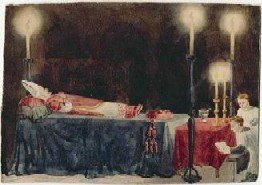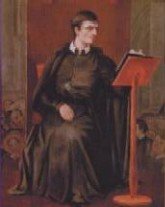History of the Cause of Cardinal Newman
In his Apostolic Constitution of 1983, Pope John Paul II reminded the Church that there was only one centre of her faith: ‘The Divine Teacher and Model of Perfection, Christ Jesus’; but, her faithful baptised members ‘are truly sons of God and sharers in the divine nature.’ And: ‘In this way, they are truly made holy.’ Moreover: ‘At various times, God chooses from among these, many who, having followed more closely the example of Christ, give outstanding testimony to the Kingdom of heaven by . . . an heroically virtuous life.’ This phenomenon hails from the very beginning of the Church, when the faithful believed that Our Lady and the Apostles and Martyrs ‘were quite closely joined to us in Christ’.
| |
 |
To these were to be added others whose exercise of the ‘divine charisms’ recommended them to the ‘devotion and imitation of the faithful’. The recognition of such outstanding virtue was at first, and for many centuries, spontaneous and local. The need to avoid illicit cult meant that increasingly, from early in the second millennium, judgment on such matters came to be vested exclusively in the Holy See. The shockwaves of the Reformation led the Church to lay down ever more stringent criteria for judging the virtue of her past members – most notable in this respect were the decrees of Pope Urban VIII and Pope Benedict XIV. Pope John Paul’s Constitution sets out to bring into harmony and give theological coherence and lucidity to all previous legislation.
John Henry Newman was born into an English Protestant world that was, at best, wary of the concept of sainthood. Within the Church of England reverence was paid to the Apostles, Martyrs and other saints of the early centuries, but scant regard was given to the saints of later centuries, for fear of approximating to dreaded ‘Popery’. In a sermon of 1831, Newman reminded his congregation that, ‘our Church teaches us to put away from ourselves the title of “Saint”.’
 Deeply grateful for Newman’s help at a time of crisis, Edward Pusey wrote to him: ‘I pray that He may make you what, as you say, there are so few of, a “great saint”.’ It may be coincidence but it is around the same time, at the end of the 1830s, we begin to find the first of what were to be countless statements of contemporaries of their conviction, that, indeed, they did have a saint in their midst. One of those who lived with Newman at Littlemore for a while reflected, after becoming a Catholic, of his surprise at having been with one ‘outside the visible Church’ yet bearing ‘the most evident marks of Christian sanctity’.
A confessed lover of peace, Newman recognised that he was destined to be ‘a man of strife’. Controversy dogged his Catholic years as it had his time as an Anglican, yet a latent recognition of his sanctity continued. At his death in 1890, countless testimonies appeared – even the staunchly Protestant Evangelical Magazine proclaimed that ‘of the multitude of saints in the Roman calendar there are very few that can be considered better entitled to that designation than Cardinal Newman.’
Intimately connected though they ever must be, reputation for sanctity and the process of canonisation present themselves in very distinct ways to the mind. No more so than to the English mind, which has often viewed such canonical procedure as arcane, mysterious, almost magical. The possibility of formal canonisation was mooted several times at Newman’s death, and, in 1907, the future Archbishop of Birmingham, John McIntyre, wrote of his own nourishing ‘the hope that our Cardinal will be the first canonised saint of the Second Spring.’ Nevertheless, there were complications such as the Modernist crisis, when some of those who stood condemned sought to invoke support from Newman’s work for their heterodox ideas. Above all, stood Saint Philip Neri and John Henry Newman, and the Oratorian ideal of self-obliteration – ‘ama nesciri’; ‘love to be unknown’, and his surviving fellow community knew how insistent he would have been in this matter, even posthumously.
Sanctity, of course, of its very nature, lives and does not die with the figure in question. Having stayed a live question, it was an American Dominican, Fr Charles Callan, who brought it out into the open by way of an article in America magazine in 1941. The response was overwhelming and positive. In 1942, the Archbishop of Toronto gave his imprimatur to the first prayer for Newman’s beatification. A fervent admirer of Newman, Pope Pius XII’s insistence on the importance of the 1945 Centenary of Newman’s Conversion gave added impetus. English reticence began to give way with a 1952 article by future Vice-Postulator, H. F. Davis, on ‘Newman’s Cause’. In 1958 Archbishop Grimshaw of Birmingham constituted the Court needed for an Ordinary Process for Canonisation. It was not realised that the paucity of living witnesses made such a Process impossible. A year later the Cause was reintroduced as an Historical Cause, and a Commission of experts assembled to gather the necessary documentary proof. The other, pressing, commitments of the Commissioners together with the apparently opaque requirements, meant that no direct progress was made. It was the cherished hope of Pope Paul VI that he would be able to mark the Holy Year of 1975 with the Beatification of John Henry Newman, but the lack of documentary progress obstructed this. It was not until 1980 that a newly reconstituted Historical Commission began the task of gathering all the necessary proofs to complete the Diocesan Process.
In May 1986, this task was completed and in the next month the findings were forwarded to the Holy See for examination by Apostolic Process. Father Vincent Blehl, S.J., who had hitherto served as Chairman of the Diocesan Commission, took on the role of Postulator and oversaw the composition of the official case (or ‘Positio’) by which the expert Consultors of the Holy See could judge the completeness and worthiness of the Cause. This Process was completed with unusual speed and unanimous endorsement. In January 1991 Pope John Paul II declared that John Henry Newman had exercised all of the Christian virtues in an heroic degree, and was henceforth to be known as ‘Venerable’. There remains the final question of miracles, one for Beatification and a further for Canonisation – hopes have been frustrated on several occasions but prayer must go on. The Postulator will report regularly on progress with mounting this final hurdle.
Mr Gerard Tracey
|